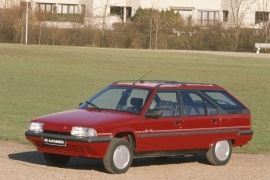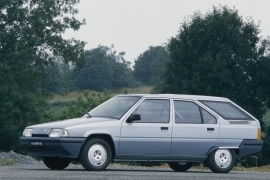CITROEN BX Break Models/Series Timeline, Specifications & Photos
First production year: 1985
Engines: Gasoline, Diesel
Body style: Wagon (station wagon, estate, combi, touring)
In 1989, Citroen refreshed the BX range, both the hatchback and the station-wagon, which was named Break.
The BX was introduced in 1982 and it was well-received by the market. It was built on the same platform with the Peugeot 405, but it received the Citroen suspension, which allowed a variable ground clearance due to the hydro-pneumatic suspension.
The car's styling was performed by Marcello Gandini, who worked for Bertone Style Studio when the car was introduced in 1982. The initial design was offered in 1979 to Volvo as a concept car named Tundra, but the Sweedish company thought it was too much for that era. Citroen bought the project and asked Bertone to make it a 4-door hatchback. And the “origami-design” was approved and appreciated by the Peugeot-Citroen board. He was in charge of the station-wagon shape as well, which he did by extending the roof and creating a new rear end. The rear doors were the same, which led to cost-cutting solutions.
Inside, the instrument cluster was cluttered with more dials, especially for the top versions that featured an electronic fuel-injection system. But it was still easy to read. The side-satellites for the turn-signals were replaced with regular stalks. Even though the car was considered as a medium-sized vehicle, it was cramped even by 1982 standards when the car was shown. In 1989 it was even more difficult.
There were few new engines installed for the 1989 model, but the most important improvement was the introduction of the all-wheel-drive system with the 1.9-liter gasoline engine.
Citroen introduced a station wagon for its BX range in 1985, and it made a difference on the market since it featured a unique suspension.
The French carmaker decided to replace the GS lineup in the '70s, but its bankruptcy prevented it from moving forward. After the marriage with Peugeot, it resumed its ideas, and its new owner helped it by giving it a new platform. Yet, some of Citroen's ideas were kept despite their higher production costs. The most important was the hydropneumatic self-leveling suspension, which proved to make a notable difference on the market, especially in the station wagon segment.
Launched on the market in 1985, the station wagon version of the BX, named Break, followed the same design ideas imagined by Marcello Gandini of Bertone. The long roof version kept even the same doors as its hatchback sibling. The most significant difference was that the roof was heightened and extended over the trunk area. At the same time, on the sides, there was a third row of rhomboidal windows between the C- and D-pillars. Moreover, the raked-forward tailgate kept the vehicle's dynamic look intact, despite being a family station wagon.
Inside, the carmaker used the same angular design language. Its squared-looking dashboard and the flat panels were cheaper to build and, in addition, followed Gandini's design concept. At the back, the folding seatback increased the trunk space from a decent 512 liters (18.1 cu-ft) to an outstanding 1,803 liters (63.7 cu-ft). Not bad at all for a 4.4-meter (14.4 ft) vehicle.
Under the hood, the carmaker decided to install only the higher-powered engines from the regular BX range. Thus, the base version came fitted with a 1.6-liter powerplant that provided 88 PS (87 hp), while the most potent version offered 105 PS (103 hp).

